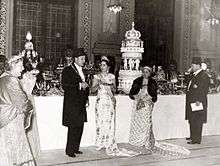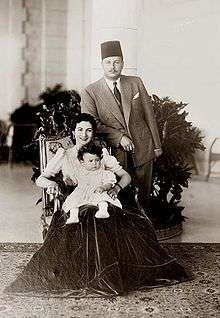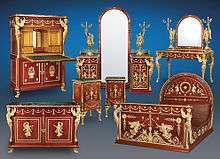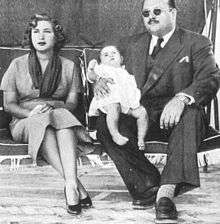Farouk of Egypt
| Farouk I فاروق الأول | |||||
|---|---|---|---|---|---|
 King Farouk I in military uniform | |||||
| King of Egypt and the Sudan[1] | |||||
| Reign | 28 April 1936 – 26 July 1952 | ||||
| Coronation | 29 July 1937[2] | ||||
| Predecessor | Fuad I | ||||
| Successor | Fuad II | ||||
| Regents | |||||
| Prime Ministers | |||||
| Born |
11 February 1920 Abdeen Palace, Cairo, Sultanate of Egypt | ||||
| Died |
18 March 1965 (aged 45) Capri, Italy | ||||
| Burial | Al-Rifa'i Mosque, Cairo, Egypt | ||||
| Spouse |
Farida (née Safinaz Zulficar) (m. 1938; div. 1948) Narriman Sadek (m. 1951; div. 1954) | ||||
| Issue |
Princess Ferial Princess Fawzia Princess Fadia Fuad II | ||||
| |||||
| Dynasty | Muhammad Ali Dynasty | ||||
| Father | Fuad I | ||||
| Mother | Nazli Sabri | ||||
| Religion | Islam | ||||
| Signature |
| ||||
Farouk I (Arabic: فاروق الأول Fārūq al-Awwal; 11 February 1920 – 18 March 1965) was the tenth ruler of Egypt from the Muhammad Ali dynasty and the penultimate King of Egypt and the Sudan, succeeding his father, Fuad I, in 1936.[3]
His full title was "His Majesty Farouk I, by the grace of God, King of Egypt and the Sudan, Sovereign of Nubia, of Kordofan and of Darfur". He was overthrown in the 1952 military coup d'état and forced to abdicate in favour of his infant son, Ahmed Fuad, who succeeded him as Fuad II. He died in exile in Italy in 1965.
His sister, Princess Fawzia Fuad, was the first wife and consort of the Shah of Iran, Mohammad Reza Pahlavi.[4]
Early life and education
He was born as His Sultanic Highness Farouk bin Fuad, Hereditary Prince of Egypt and Sudan, on 11 February 1920 at Abdeen Palace, Cairo, the eldest child of Sultan Fuad I (later King Fuad I) and his second wife, Nazli Sabri.[5][6] He was of 10/16 Circassian (bilineal), 3/16 Turkish (bilineal), 2/16 French (matrilineal) and 1/16 Albanian (patrilineal) descent.[7][8][9]
In addition to his sisters, Fawzia, Faiza, Faika and Fathia,[10] he had two half-siblings from his father's previous marriage to Princess Shwikar Khanum Effendi. Before his father's death, he was educated at the Royal Military Academy, Woolwich, England.
Reign
Upon his coronation, the 16-year-old King Farouk made a public radio address to the nation, the first time a sovereign of Egypt had ever spoken directly to his people in such a way:
| “ | And if it is God's will to lay on my shoulders at such an early age the responsibility of kingship, I on my part appreciate the duties that will be mine, and I am prepared for all sacrifices in the cause of my duty.... My noble people, I am proud of you and your loyalty and am confident in the future as I am in God. Let us work together. We shall succeed and be happy. Long live the Motherland! | ” |
Farouk was enamored of the glamorous royal lifestyle. Although he already had thousands of acres of land, dozens of palaces and hundreds of cars, the youthful king often travelled to Europe for grand shopping sprees, earning the ire of many of his subjects. It is said that he ate 600 oysters a week.[11] His personal vehicle was a red 1947 Bentley Mark VI, with coachwork by Figoni et Falaschi; he dictated that, other than the military jeeps which made up the rest of his entourage, no other cars were to be painted red.[12] In 1951, he bought the pear-shaped 94-carat Star of the East Diamond and a fancy-coloured oval-cut diamond from jeweller Harry Winston.

Princess Nimet Mouhtar (1876–1945), Farouk's paternal aunt;
King Farouk I (1920–1965), the groom;
Queen Farida (1921–1988), the bride;
Sultana Melek (1869–1956), widow of Hussein Kamel, Farouk's paternal uncle;
Prince Muhammad Ali Ibrahim (1900–1977), Farouk's 2nd cousin once removed.
He was most popular in his early years, and the nobility largely celebrated him. For example, during the accession of the young King Farouk, "the Abaza family had solicited palace authorities to permit the royal train to stop briefly in their village so that the king could partake of refreshments offered in a large, magnificently ornamented tent the family had erected in the train station."[13] The Chief Accountant to Farouk was Yadidya Israel. However, secretly he worked with the Free Officers Movement to overthrow Farouk. The ironies of history also meant that the Abaza family's own Wagih Abaza was in the Free Officers movement that removed the King in 1952, later becoming governor of six governorates in post-Farouk Egypt.[14][15][16]
Farouk's accession initially was encouraging for the populace and nobility, due to his youth and Egyptian roots through his mother Nazli Sabri. However, the situation was not the same with some Egyptian politicians and elected government officials, with whom Farouk quarrelled frequently, despite their loyalty in principle to his throne. There was also the issue of the continuous British involvement in the Egyptian government, which Farouk struggled to resist.
During the hardships of the Second World War, criticism was levelled at Farouk for his lavish lifestyle. His decision not to put out the lights at his palace in Alexandria when the city was blacked out because of German and Italian bombing was deemed particularly offensive by the Egyptian people. This was a large contrast to the British royal family back in England, who were well known to have an opposite reaction to the bombings near their home. Owing to the continuing British occupation of Egypt, many Egyptians, Farouk included, were positively disposed towards Germany and Italy, and despite the presence of British troops, Egypt remained officially neutral until the final year of the war. Consequently, Farouk's Italian servants were not interned, and there is an unconfirmed story that Farouk told British Ambassador Sir Miles Lampson (who had an Italian wife), "I'll get rid of my Italians when you get rid of yours". In addition, Farouk was known for harbouring certain Axis sympathies and even sending a note to Adolf Hitler saying that an invasion would be welcome.[17]
Following a ministerial crisis in February 1942, the British government, through its ambassador in Egypt, Sir Miles Lampson, pressed Farouk to have a Wafd or Wafd-coalition government replace Hussein Sirri Pasha's government. On the night of 4 February 1942, British troops and tanks surrounded Abdeen Palace in Cairo and Lampson presented Farouk with an ultimatum. Farouk capitulated, and Nahhas formed a government shortly thereafter. However, the humiliation meted out to Farouk, and the actions of the Wafd in co-operating with the British and taking power, lost support for both the British and the Wafd among both civilians and, more importantly, the military. With this, Farouk's popularity seemed to decrease significantly, especially with the rise of Arab nationalism, many of the people in the country viewed him as a puppet to the powers of the West.
Farouk declared war on the Axis Powers only under heavy British pressure in 1945, long after the fighting in Egypt's Western Desert had ceased.
On 17 October 1951 the Egyptian government got Parliamentary approval to cancel the 1936 Anglo-Egyptian Treaty. As a result, the British forces in the Suez Canal were considered occupation forces and King Farouk was declared "King of Egypt and Sudan". This title was not recognised by many countries, and Egypt entered diplomatic debates as well as internal political unrest.
Farouk is also reported as having said "The whole world is in revolt. Soon there will be only five Kings left – the King of England, the King of Spades, the King of Clubs, the King of Hearts, and the King of Diamonds."[18]
Overthrow
Farouk was widely condemned for his corrupt and ineffectual governance, the continued British occupation, and the Egyptian army's failure in the 1948 Arab–Israeli War to prevent the creation of the state of Israel. Public discontent against Farouk rose to new levels. Finally, on 23 July 1952, the Free Officers, led by Muhammad Naguib and Gamal Abdel Nasser, staged a military coup that launched the Egyptian Revolution of 1952. Farouk was forced to abdicate, and went into exile in Monaco and Italy, where he lived for the rest of his life. Immediately following his abdication, Farouk's baby son, Ahmed Fuad, was proclaimed King Fuad II, but for all intents and purposes Egypt was now governed by Naguib, Nasser and the Free Officers. On 18 June 1953, the revolutionary government formally abolished the monarchy, ending 150 years of the Muhammad Ali dynasty's rule, and Egypt was declared a republic.
The Egyptian government quickly moved to auction off the King's vast collection of trinkets and treasures,[19] including his seven-piece bedroom suite that was inspired by Napoleon and Josephine's suite at the Château de Malmaison.[20] Among the more famous of his possessions was one of the rare 1933 Double Eagle coins, though the coin disappeared before it could be returned to the United States. (It later reappeared in New York in 1996 and was eventually sold at auction for more than seven million dollars.)[21]
The 94-carat Star of the East diamond and another diamond bought from Harry Winston had not been paid for by the time of the King's overthrow in 1952; three years later an Egyptian government legal board entrusted with the disposal of the former royal assets, ruled in Winston's favour. Nevertheless, several years of litigation were needed before Winston was able to reclaim the Star of the East from a safe-deposit box in Switzerland.
Exile and death
Farouk fled Egypt in great haste, and his abandoned possessions—including a huge collection of pornography—became objects of curiosity and ridicule.[22]
On his exile from Egypt, Farouk settled first in Monaco, and later in Rome. On 29 April 1958, the United Arab Republic, a federation of Egypt and Syria, issued rulings revoking his citizenship.[23] He was granted Monegasque citizenship in 1959 by his close friend Prince Rainier III.[24]
Farouk was thin early in his reign but later gained weight. He died in the Ile de France restaurant in Rome on 18 March 1965, collapsing at his dinner table after being poisoned by Ibrahim al Baghdady, sent by Gamal Abdel Nasser.[25] While some claim he was poisoned by Egyptian Intelligence,[26] no official autopsy was conducted on his body. His will stipulated that he be buried in the Al Rifa'i Mosque in Cairo, but the request was denied by the Egyptian government under Gamal Abdel Nasser, and he was buried in Italy. The funeral service held in Rome was attended by his mother, Nazli Sabri.[27] King Faisal of Saudi Arabia stated he would be willing to have King Farouk buried in Saudi Arabia, upon which President Nasser said that the former monarch could be buried in Egypt, but not in Rifai' mosque. The body of King Farouk returned to Egypt on 31 March 1965 at night and was secretly buried in the Ibrahim Pasha Burial Site in Imam El Shafi' area.[28]
During Anwar El-Sadat's presidency, the remains were moved to Al-Rifa'i Mosque.
Marriages and affairs

Farouk was married twice, with a claim of a third marriage. His first wife was Safinaz Zulficar (1921–1988), the daughter of Youssef Zulficar Pasha. Safinaz was renamed Farida upon her marriage. They were married in January 1938.[29] The marriage was under a large amount of stress due to Queen Farida's inability to produce a male heir, which Farouk found essential to maintain his throne. After producing three daughters, the couple divorced in 1948.
In 1950, Farouk was smitten by a commoner named Narriman Sadek (1933–2005) and after courting, the two married in 1951. Sadek was eighteen years old when she married the king and many believed the attraction was due to Farouk's belief that she would give him the male heir he desired. He got what he wanted when Sadek gave birth to the future King Fuad II in 16 January 1952. However, months after the prince's birth the king and his queen were expelled from Egypt, and divorced in 1954.
He also had many affairs, among them, in 1950, British writer Barbara Skelton. In 1955 his eye fell on the Boston socialite-become-singer Pat Rainey.[30] While in exile in Italy, Farouk met Irma Capece Minutolo, an opera singer, who became his companion. In 2005, she claimed that she married the former King in 1957.[31]
Children
| Name | Birth | Death | Spouse | Children |
|---|---|---|---|---|
| Princess Farial | 17 November 1938 | 29 November 2009 | Jean-Pierre Perreten Divorced 1967 |
Yasmine Perreten-Shaarawi (b. 1967) |
| Princess Fawzia | 7 April 1940 | 27 January 2005 | ||
| Princess Fadia | 15 December 1943 | 28 December 2002 | Pierre Alexievitch Orloff | Michael-Shamel Orloff (b. 1966) Alexander-Ali Orloff (b. 1969) |
| King Fuad II | 16 January 1952 | Dominique-France Loeb-Picard Divorced 1996 |
Muhammad Ali, Prince of the Sa'id (b. 1979) Princess Fawzia-Latifa (b. 1982) Prince Fakhruddin (b. 1987) | |
Hobbies
Coin collection
King Farouk amassed one of the most famous coin collections in history which included an extremely rare American gold minted 1933 double eagle coin[32] and (non-concurrently), two 1913 Liberty Head nickels.[33]
Style
The ostentatious king's name is used to describe imitation Louis XV-style furniture known as "Louis-Farouk".[34] The imperial French style furniture became fashionable among Egypt's upper classes during Farouk's reign so Egyptian artisans began to mass-produce it. The style uses ornate carving, is heavily gilded, and is covered in elaborate cloth.[35] The style, or imitations thereof, remains widespread in Egypt.
Titles, styles and honours
| Styles of Farouk I of Egypt | |
|---|---|
 | |
| Reference style | His Majesty |
| Spoken style | Your Majesty |
| Alternative style | Sir |
Titles
- 11 February 1920 – 15 March 1922: His Sultanic Highness The Hereditary Prince of Egypt and Sudan
- 15 March 1922 – 12 December 1933: His Royal Highness The Crown Prince of Egypt and Sudan
- 12 December 1933 – 28 April 1936: His Royal Highness The Prince of the Sa'id
- 28 April 1936 – 16 October 1951: His Majesty The King of Egypt, Sovereign of Nubia, Sudan, Kordofan, and Darfur
- 16 October 1951 – 26 July 1952: His Majesty The King of Egypt and the Sudan
- 26 July 1952 – 18 March 1965: His Majesty King Farouk I of Egypt
Honours
National dynastic honours
.svg.png)
.svg.png)
.svg.png)
.svg.png)
.svg.png)
.svg.png)
.svg.png)
.svg.png)
.svg.png)
.svg.png)
.svg.png)
.svg.png)
.svg.png)
.svg.png)
.svg.png)
.svg.png)
.svg.png)
.svg.png)
.svg.png)
Foreign honours
.svg.png)

.svg.png)

.svg.png)


In popular culture
Gore Vidal's 1953 pulp novel Thieves Fall Out is set against his overthrow.
Agatha Christie's short story The Adventure of the Christmas Pudding involves the theft of a jewel from a fictional Eastern prince who is somewhat irresponsible and fond of a luxurious lifestyle. His name and origin are not given in the original story, but in the 1991 television adaptation in the series Agatha Christie's Poirot (where the story appears under its American title, The Theft of the Royal Ruby), the story is altered and the prince identified as Farouk (played by Tariq Alibai). This adaptation presents the British government as concerned to help Farouk recover the jewel to maintain his standing in his home country, eventually succeed his father Fuad I of Egypt to the throne, and curb the influence of the nationalist Wafd Party.
In 2007, the MBC aired an Egyptian television series titled Al Malik Farouk about the life of King Farouk and he was portrayed by Syrian actor Taym Hassan.[5][46]
Bestselling author Warren Adler's (The War of the Roses) historical thriller Mother Nile follows a fictionalised account of several characters devastated by life in Cairo, Egypt during King Farouk's reign.
A "Woman of Cairo", written by Noel Barber, offers an inside look of Farouk's palace intrigues and scandals.
"Who do you think you are, King Farouk?" was a common verbal admonishment used among parents in English speaking countries to their children during the mid 50's to late 60's. The putdown was often used when a request from a child was viewed as too expensive, unreasonable or outlandish.
Bruce Springsteen’s song “Aint’ Got You" from the 1987 album Tunnel of Love includes the line “I got more good luck honey than old King Farouk.”
Ancestry
| Ancestry of Farouk of Egypt[47] | ||||||||||||||||||||||||||||||||||||||||||||||||||||||||||||||||||||||||||||||||||||||||||||||||||||||||||||||||||||||||||||||||||||||||||||||||||||||||||||||||||||||||||||||||||||||||||||||||||||||||||||||||||||||||||||||||||||||||||||||||||||||||||||||||||||||||||||||||||||||||||||||||||||||||||||||||||||||||||||||||||||||||||||||||||||||||||||||||||||||||||||||||||||||||||||||||||||||||||||||||||||||||||||||||||||||||||||||||||||||||||||||||||||||||||||||||||||||||||||||||||||||||||||||||||||||||||||||||||||||||||||||||||||||||||||||||||||||||||||||||||||||||||||||||||||||||||||||||
|---|---|---|---|---|---|---|---|---|---|---|---|---|---|---|---|---|---|---|---|---|---|---|---|---|---|---|---|---|---|---|---|---|---|---|---|---|---|---|---|---|---|---|---|---|---|---|---|---|---|---|---|---|---|---|---|---|---|---|---|---|---|---|---|---|---|---|---|---|---|---|---|---|---|---|---|---|---|---|---|---|---|---|---|---|---|---|---|---|---|---|---|---|---|---|---|---|---|---|---|---|---|---|---|---|---|---|---|---|---|---|---|---|---|---|---|---|---|---|---|---|---|---|---|---|---|---|---|---|---|---|---|---|---|---|---|---|---|---|---|---|---|---|---|---|---|---|---|---|---|---|---|---|---|---|---|---|---|---|---|---|---|---|---|---|---|---|---|---|---|---|---|---|---|---|---|---|---|---|---|---|---|---|---|---|---|---|---|---|---|---|---|---|---|---|---|---|---|---|---|---|---|---|---|---|---|---|---|---|---|---|---|---|---|---|---|---|---|---|---|---|---|---|---|---|---|---|---|---|---|---|---|---|---|---|---|---|---|---|---|---|---|---|---|---|---|---|---|---|---|---|---|---|---|---|---|---|---|---|---|---|---|---|---|---|---|---|---|---|---|---|---|---|---|---|---|---|---|---|---|---|---|---|---|---|---|---|---|---|---|---|---|---|---|---|---|---|---|---|---|---|---|---|---|---|---|---|---|---|---|---|---|---|---|---|---|---|---|---|---|---|---|---|---|---|---|---|---|---|---|---|---|---|---|---|---|---|---|---|---|---|---|---|---|---|---|---|---|---|---|---|---|---|---|---|---|---|---|---|---|---|---|---|---|---|---|---|---|---|---|---|---|---|---|---|---|---|---|---|---|---|---|---|---|---|---|---|---|---|---|---|---|---|---|---|---|---|---|---|---|---|---|---|---|---|---|---|---|---|---|---|---|---|---|---|---|---|---|---|---|---|---|---|---|---|---|---|---|---|---|---|---|---|---|---|---|---|---|---|---|---|---|---|---|---|---|---|---|---|---|---|---|---|---|---|---|---|---|---|---|---|---|---|---|---|---|---|---|---|---|---|---|---|---|---|---|---|---|---|---|---|---|---|---|---|---|---|---|---|---|---|---|---|---|---|---|---|---|---|---|---|---|---|---|---|---|---|---|---|---|---|---|---|---|---|---|---|---|---|---|---|---|---|---|---|---|---|---|---|---|---|---|---|---|---|---|---|---|---|---|---|---|---|---|---|---|---|---|---|---|---|---|---|---|---|---|---|---|---|---|---|---|---|---|---|---|---|---|---|---|---|---|---|---|---|---|---|---|---|---|---|---|---|---|---|---|---|---|---|---|---|---|---|
| ||||||||||||||||||||||||||||||||||||||||||||||||||||||||||||||||||||||||||||||||||||||||||||||||||||||||||||||||||||||||||||||||||||||||||||||||||||||||||||||||||||||||||||||||||||||||||||||||||||||||||||||||||||||||||||||||||||||||||||||||||||||||||||||||||||||||||||||||||||||||||||||||||||||||||||||||||||||||||||||||||||||||||||||||||||||||||||||||||||||||||||||||||||||||||||||||||||||||||||||||||||||||||||||||||||||||||||||||||||||||||||||||||||||||||||||||||||||||||||||||||||||||||||||||||||||||||||||||||||||||||||||||||||||||||||||||||||||||||||||||||||||||||||||||||||||||||||||||
See also
Further reading
- Ashraf Pahlavi. Faces in a Mirror, Englewood Cliffs: Prentice-Hall, Inc., 1980
- McLeave, Hugh. The Last Pharaoh: Farouk of Egypt, New York: McCall Pub. Co., 1970, 1969 ISBN 0-8415-0020-7.
- New King, Old Trouble Time Magazine, Monday, 11 May 1936.
- Morewood, Steve. The British Defence of Egypt, 1935-40: Conflict and Crisis in the Eastern Mediterranean (Routledge, 2008).
- O'Sullivan, Christopher D. FDR and the End of Empire: The Origins of American Power in the Middle East. (Palgrave Macmillan, 2012)
- Sadat, Jehan. A Woman of Egypt, New York: Simon and Schuster, 1987 ISBN 0-671-72996-9
- Stadiem, William. Too Rich: The High Life and Tragic Death of King Farouk, New York: Carroll & Graf Pub, 1991 ISBN 0-88184-629-5
- Thornhill, Michael T. "Informal Empire, Independent Egypt and the Accession of King Farouk." Journal of Imperial and Commonwealth History 38.2 (2010): 279-302.
References
- ↑ Whiteman, Marjorie Millace; Hackworth, Green Haywood (1963). Digest of International Law (snippet view). Vol. 2. U.S. State Department. p. 64. OCLC 79506166. Retrieved 26 February 2010.
The Egyptian Parliament amended the Constitution by Law 176 of 16 October 1951, to provide that the title of the King should be "King of Egypt and the Sudan" instead of "King of Egypt, Sovereign of Nubia, Sudan, Kordofan and Darfur".
- ↑ Rizk, Yunan Labib (28 July – 3 August 2005). "Crowning moment". Al-Ahram Weekly (753). Archived from the original on 14 September 2008. Retrieved 25 February 2010.
- ↑ "Egypt". royalark.net.
- ↑ "Princess Fawzia Fuad of Egypt". The Telegraph. 5 July 2013. Retrieved 16 July 2013.
- 1 2 "Biography for King Farouk". IMDb. Retrieved 17 July 2013.
- ↑ John E. Jessup (1998). An Encyclopedic Dictionary of Conflict and Conflict Resolution, 1945-1996. Greenwood Publishing Group. p. 205. ISBN 978-0-313-28112-9. Retrieved 8 February 2013.
- ↑ Montgomery-Massingberd, Hugh, ed. (1980). "The French Ancestry of King Farouk of Egypt". Burke's Royal Families of the World. Volume II: Africa & the Middle East. London: Burke's Peerage. p. 287. ISBN 978-0-85011-029-6. OCLC 18496936.
- ↑ Goldschmidt, Arthur (2000). Biographical dictionary of modern Egypt. Lynne Rienner Publishers. p. 191. ISBN 1-55587-229-8.
- ↑ "Ancestors of Queen Nazli" (JPG). Egy.com. Retrieved 1 March 2010.
- ↑ "Nazli". A Bit of History. Retrieved 15 August 2013.
- ↑ Morrow, Lance (31 March 1986). "Essay: The Shoes of Imelda Marcos". Time.
- ↑ "Restoring Rusty Relics", "Cars of old purr like new"; Marjorie Keyishian, The New York Times, 18 July 1991
- ↑ "The making of a king". Al-Ahram Weekly. 5 October 2005. Archived from the original on 14 August 2008.
- ↑ Baraka, Mohamed. "Al-Ahram Weekly - Entertainment - Lawsuits, love and heartbreak".
- ↑ Peeters, Sander. "Egypt's Forgotten Lysanders".
- ↑ "The EAF 's Diamond Anniversary".
- ↑ Pinkus, Oscar (2005). "Fortress Europe". The war aims and strategies of Adolf Hitler (preview)
|format=requires|url=(help). Jefferson, North Carolina: McFarland & Company, Inc. p. 161. Retrieved 27 July 2010. - ↑ "Quotation #86". The Quotation Page.
- ↑ "Sale of the Century". The Sun-Herald. Sydney, New South Wales. 31 January 1954. p. 13. Retrieved 11 April 2013.
- ↑ "Prime Provenance: The King Farouk Bedroom Suite". ArtfixDaily. Retrieved 24 November 2015.
- ↑ Susan Headley. "1933 Gold Double Eagle". About.com.
- ↑ Foreign News: A King's Home Time, 8 September 1952.
- ↑ Halsey, William Darrach; Friedman, Emanuel (1983). "Faruk I". Collier's Encyclopedia with Bibliography and Index (snippet view)
|format=requires|url=(help). 9. New York: Macmillan Educational Co. p. 574. OCLC 9355858. Retrieved 25 February 2010. - ↑ "Monaco Makes Farouk Citizen". Deseret News. 351 (107): A3. 5 May 1959. Retrieved 25 February 2010.
- ↑ "Egypt: A Tale of Two Autocrats". Time. 26 March 1965.
- ↑ "Farouk of Egypt". Mad Monarchs. Archived from the original on 26 October 2009. Retrieved 26 February 2010.
- ↑ Ahmed Maged (6 February 2008). "Revealing book on Queen Nazli depicts her tragic life in exile". Daily News Egypt. Cairo. Retrieved 6 September 2013.
- ↑ Al-Ahram newspaper 31 March 1965
- ↑ "Colorful Fetes Mark Royal Wedding that will Link Egypt and Persian". The Meriden Daily Journal. 13 March 1939. Retrieved 8 August 2013.
- ↑ "Singer Pat Rainey and King Farouk Rumored To Be An Item," Jet, 3 November 1955. https://www.flickr.com/photos/vieilles_annonces/1387933349
- ↑ "Thrice-married man?". Al-Ahram Weekly. 23 March 2005. Archived from the original on 16 December 2008.
- ↑ Lester, Carl N. "Numismatic "Gumshoe:" On the Trail of King Farouk". Gold Rush Gallery.
- ↑ "1913 Liberty Head Five Cents". Coinfacts. Retrieved 18 June 2012.
- ↑ "King Farouk's Massive, $1M Mercury-Gilded Mahogany Bedroom Set Rivals Louis XV's". ArtfixDaily. Retrieved 24 November 2015.
- ↑ Burke, C: Lee Miller, a life, page 151. University of Chicago Press, 2005
- ↑ https://66.media.tumblr.com/fdad04cb7161a2db88afc7dd4dc097e7/tumblr_o0i72uCiWG1rwjpnyo1_500.jpg
- ↑ http://i.dailymail.co.uk/i/pix/2011/11/15/article-2061882-0E421F7800000578-355_306x439.jpg
- 1 2 3 , King Farouk wears the 3 Egyptian orders: Muhammad Ali, Ismail and the Nile
- ↑ https://c2.staticflickr.com/8/7035/6541366649_b3f28d3658_b.jpg
- 1 2 3 , King Farouk wearing orders of France, Monaco and Spain
- ↑ http://www.edwardquinn.com/Celebrities/Farouk_king_Egypt_files/Faruk_King_Daughter73A_1.jpg
- ↑ https://mahayoussuf.files.wordpress.com/2007/11/queen-nazli-king-farouk-sultana-malk-the-widow-of-sultan-hussein-kamal-the-uncle-of-king-farouk.jpg
- ↑ "Farouk of Egypt attending the wedding of Rainier III and Grace Kelly Pictures - Getty Images".
- ↑ http://www.boe.es/datos/pdfs/BOE//1951/094/A01479-01479.pdf
- 1 2 "Cidadãos Estrangeiros Agraciados com Ordens Portuguesas". Página Oficial das Ordens Honoríficas Portuguesas. Retrieved 1 August 2017.
- ↑ Halawi, Jailan (27 September – 3 October 2007). "A monarch rehabilitated". Al Ahram Weekly. 862. Archived from the original on 7 May 2013. Retrieved 6 September 2013.
- ↑ Montgomery-Massingberd, Hugh, ed. (1980). "The French Ancestry of King Farouk of Egypt". Burke's Royal Families of the World. Volume II: Africa & the Middle East. London: Burke's Peerage. p. 287. ISBN 978-0-85011-029-6. OCLC 18496936.
External links
- الملك فاروق الأول [King Farouk I] (in Arabic). Bibliotheca Alexandrina: Memory of Modern Egypt Digital Archive. Retrieved 27 February 2010.
| Wikimedia Commons has media related to Farouk I of Egypt. |
- Newspaper clippings about Farouk of Egypt in the 20th Century Press Archives of the German National Library of Economics (ZBW)
Farouk of Egypt Born: 11 February 1920 Died: 18 March 1965 | ||
| Regnal titles | ||
|---|---|---|
| Preceded by Fuad I |
King of Egypt Sovereign of Nubia, the Sudan, Kordofan and Darfur 1936–1951 |
Name of title changed by Law 176 of 16 October 1951 |
| New title Name of title changed by Law 176 of 16 October 1951 |
King of Egypt and the Sudan 1951–1952 |
Succeeded by Fuad II |
| Egyptian royalty | ||
| Vacant British Protectorate Title last held by Prince Muhammad Abdel Moneim |
Heir to the Throne 1920–1933 |
Succeeded by Prince Muhammad Ali Tawfiq |
| New title | Prince of the Sa'id as heir apparent 1933–1936 |
Vacant Title next held by Ahmad Fuad, Prince of the Sa'idlater became King Fuad II |

